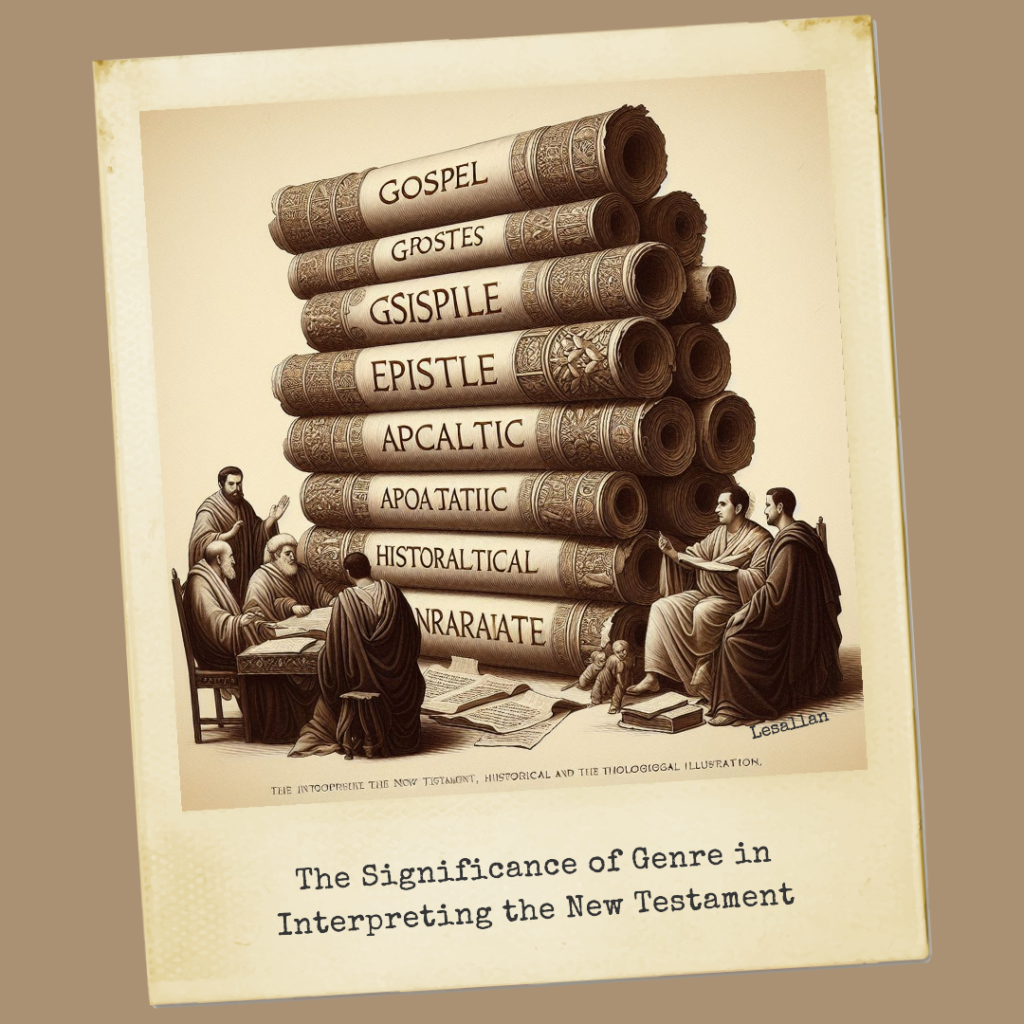Ohio Christian University
BIB2025 New Testament Interpretation (ONLSP24)
Professor Matthew Benson
April 22, 2024

The Significance of Genre in Interpreting the New Testament
The New Testament (New International Version, 2019), a cornerstone of Christian theology, is a collection of 27 books written in the first century AD. These texts, written during significant religious and political upheaval, have profoundly shaped Christian thought and practice (Craig Alan Evans et al., 2000). The notion of genre, which refers to a distinct classification or category of literature, holds a significant position in interpreting literary works. Genre functions as a framework that directs the reader’s expectations and comprehension in a particular direction. The importance of genre becomes even more pronounced when examining ancient texts, such as the New Testament (Craig Alan Evans et al., 2000).
The genre of a text plays a pivotal role in shaping the reader’s understanding and interpretation of the text, making it an invaluable tool in the realm of literary analysis. Identifying and evaluating genre in texts necessitates a meticulous and critical approach, as it can have far-reaching implications on the interpretation and understanding of a given work. A comprehensive analysis of genre in a text can offer valuable insights into the work’s intended audience, authorial intent, and historical context, among other factors (Craig Alan Evans et al., 2000). Therefore, a thorough understanding of genre is essential for any reader or scholar seeking to engage with literary texts critically and meaningfully.
The four canonical Gospels of Matthew, Mark, Luke, and John (New International Version, 2019) have been widely studied for their historical, theological, and literary significance. These texts, written in the genre of ancient biography, offer a unique and invaluable account of the life and teachings of Jesus Christ, who is widely regarded as one of the most influential figures in human history (Craig Alan Evans et al., 2000). The study of the Gospels as ancient biographies has become a crucial area of research in the field of New Testament studies.
The genre of literature that is being referred to is unmistakably characterized by its unwavering focus on the life story of a singularly significant person, and this person, in the case of the Gospels, is none other than Jesus Christ himself. His remarkable life, teachings, and works have undoubtedly and profoundly impacted human civilization as we know it. In their unique genre, the Gospels provide insights into Jesus’ life and teachings that are unparalleled in any other form of literature (Craig Alan Evans et al., 2000).
The genre of ancient biography was popular in the Greco-Roman world, and the Gospels exhibit many of the same features as other examples of this literary form. These include focusing on the main character’s birth, childhood, public life, death, and concern for the person’s character, deeds, and teachings. The Gospels also include elements of other literary genres, such as miracle stories, parables, and apocalyptic literature, reflecting the authors’ religious and cultural context and audiences (Craig Alan Evans et al., 2000).
By understanding the genre in which the Gospels were written, scholars can better appreciate the central theme of the texts, which is the life, teachings, and works of Jesus Christ. The Gospels present a complex and nuanced portrayal of Jesus, emphasizing His compassion, wisdom, authority, suffering, and death on the cross. The Gospels have served as a source of inspiration and guidance for believers throughout the ages, and their impact on Western culture cannot be overstated. The study of the Gospels as ancient biographies thus remains a vital and ongoing endeavor for scholars and laypersons alike (Craig Alan Evans et al., 2000).
One of the most notable features of the Gospels is the use of parables, a common literary device in ancient literature. Parables are an effective tool to impart moral and spiritual lessons by presenting abstract concepts in a tangible and relatable manner. Through the use of parables, Jesus communicated complex ideas about the nature of God, the purpose of human existence, and the importance of living a virtuous life in a way that was accessible to his audience. In this way, the Gospels serve not only as historical and biographical accounts of the life of Jesus Christ. They are also profound works of literature that continue to impact human thought and culture profoundly (Craig Alan Evans et al., 2000).
The Book of Acts (New International Version, 2019), written by Luke, holds a unique position in the New Testament’s collection of books. It represents a blend of biography, detailing the life and works of Peter and Paul and history, providing an account of the early Christian church’s development. By recognizing this genre, we can appreciate Acts as a historical narrative that bridges the gap between the Gospels and the Epistles. This bridging function is particularly significant since the Gospels focus on the life and teachings of Jesus Christ, while the Epistles provide guidance to the early Christian communities. Acts, therefore, link the two genres, portraying the formation of the early church and its progression from its roots in Jerusalem to its expansion throughout the known world. Moreover, Acts serves as the primary source of information regarding establishing the church’s leadership and organizational structure. Thus, it is essential to understand the New Testament’s historical context and the early Christian church’s development (Craig Alan Evans et al., 2000).
The Epistles, an integral part of the New Testament (New International Version, 2019), presents a compendium of letters authored by prominent apostles, including Paul, Peter, and John, directed toward various churches and individuals. These epistolary writings are widely regarded as fundamental sources of guidance, correction, encouragement, and teachings on Christian doctrine. To fully appreciate the significance of these letters, it is imperative to comprehend the epistolary genre and the context in which they were written. The epistolary genre is an ancient form of communication that involves the exchange of letters between individuals for various purposes, such as conveying personal and intimate messages, political and social commentary, and religious and philosophical discourse. The epistolary writings of the New Testament, written during the early Christian era, provide invaluable insights into specific situations and challenges encountered by early Christian communities. Consequently, a thorough understanding of the epistolary genre is essential in interpreting these writings in their proper context and comprehending their role in shaping the early Christian church. The Epistles offers a unique window into the personal lives and beliefs of the early Christian leaders, and they represent a crucial component of the rich tapestry of theological and historical traditions that continue to inform contemporary Christianity (Craig Alan Evans et al., 2000).
The Book of Revelation (New International Version, 2019) is a highly symbolic and vividly imagined work of apocalyptic literature. This genre employs visionary language to convey a worldview in which God intervenes in human history, ultimately securing a final triumph of good over evil. Revelation’s message is one of hope and encouragement for persecuted Christians rather than a literal prediction of specific end times and events. To fully appreciate the meaning of Revelation, it is necessary to understand the conventions of apocalyptic literature. These works are typically written during times of crisis and upheaval when the author and their community are experiencing intense persecution and hardship. In this context, the imagery and symbolism used in Revelation serve an important function. They offer a way of interpreting and understanding current events in the context of God’s plan for the world (Craig Alan Evans et al., 2000).
The Book of Revelation is often seen as a response to the persecution of Christians under the Roman Empire. The author, traditionally identified as apostle John, wrote the book from the island of Patmos, where he was exiled for his beliefs. The apocalyptic visions he describes in Revelation are a powerful expression of the hope and faith that sustained him and his fellow believers in the face of persecution (Craig Alan Evans et al., 2000).
Despite its reputation as a problematic and obscure work, the Book of Revelation has profoundly influenced Christian thought and culture throughout the centuries. It has themes of redemption, judgment, and the ultimate triumph of good over evil continue to resonate with readers today. By studying Revelation within the context of apocalyptic literature, we can better understand its message and its enduring significance for Christian theology and practice (Craig Alan Evans et al., 2000).
To understand the New Testament (New International Version, 2019) accurately, it is essential to appreciate the diverse genres in which its books were written. From the biographical Gospels to the apocalyptic Revelation, each genre presents a distinct perspective that contributes to the rich tapestry of the New Testament as a whole. As such, it is vital to recognize and appreciate these genres, not only for their literary value but also for their theological significance. By exploring each genre’s unique characteristics and themes, we can better understand the New Testament’s message and its relevance to our lives today. Through careful analysis and interpretation, we can unlock these ancient texts’ full potential and appreciate their enduring impact on Western civilization and beyond.
References:
Craig Alan Evans, Porter, S. E., & Evans, G. (2000). Dictionary of New Testament background. Intervarsity Press, Cop.
New International Version. (2019). New international version Bible – read free online. Bible Study Tools. https://www.biblestudytools.com/niv/


